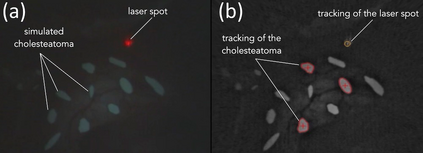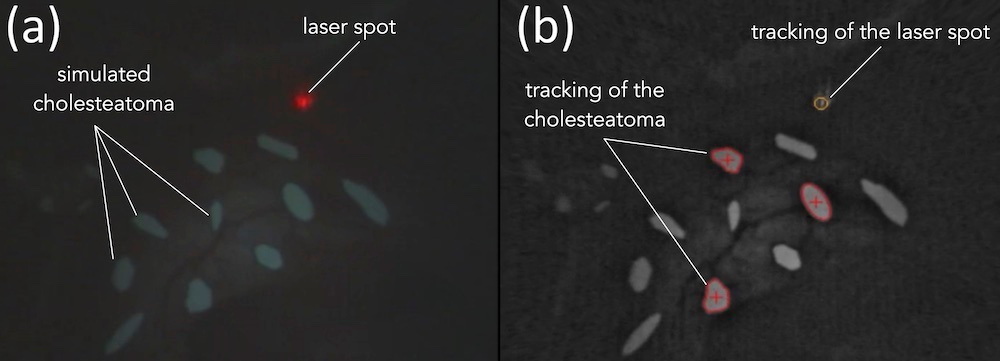This paper deals with the control of laser spot in the context of minimally invasive surgery of the middle ear, e.g., cholesteatoma removal. More precisely, our work is concerned with the exhaustive burring of residual infected cells after primary mechanical resection of the pathological tissues since the latter cannot guarantee the treatment of all the infected tissues, the remaining infected cells cause regeneration of the diseases in 20%-25\-% of cases, which require a second surgery 12-18 months later. To tackle such a complex surgery, we have developed a robotic platform that consists of the combination of a macro-scale system (7 degrees of freedom (DoFs) robotic arm) and a micro-scale flexible system (2 DoFs) which operates inside the middle ear cavity. To be able to treat the residual cholesteatoma regions, we proposed a method to automatically generate optimal laser scanning trajectories inside the regions and between them. The trajectories are tacked using an image-based control scheme. The proposed method and materials were validated experimentally using the lab-made robotic platform. The obtained results in terms of accuracy and behaviour meet perfectly the laser surgery requirements.
翻译:本文涉及在中耳最小侵入性外科的情况下对激光点的控制,例如胆碱酯酶除去;更确切地说,我们的工作涉及在病理组织进行初级机械分解后,对受感染的残余细胞进行彻底埋设,因为病理组织不能保证治疗所有受感染组织,其余受感染细胞在20%-25%-25%-百分比的病例中造成疾病的再生,这需要12-18个月之后进行第二次外科手术。为了处理这种复杂的外科手术,我们开发了一个机器人平台,它由大型系统(7度自由(DOF)机器人臂)和在中耳洞内运作的微型规模灵活系统(2DF)的结合组成。为了能够治疗所有受感染组织,我们建议了一种方法,在区域内和它们之间自动产生最佳的激光扫描轨迹,采用基于图像的控制办法。提议的方法和材料是用实验室机器人平台进行实验验证的。在准确性和行为上取得的结果符合完全的激光要求。













